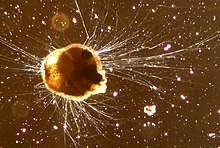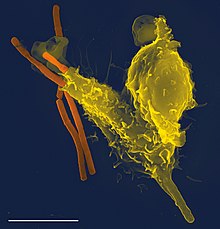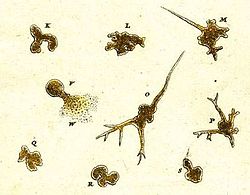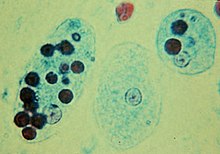Amoeba

An amoeba (
Microbiologists often use the terms "amoeboid" and "amoeba" interchangeably for any organism that exhibits amoeboid movement.[8][9]
In older classification systems, most amoebae were placed in the
The best known amoeboid
Shape, movement and nutrition

Amoeba do not have cell walls, which allows for free movement. Amoeba move and feed by using pseudopods, which are bulges of
Free-living amoebae may be "
To regulate
Diet
The food sources of amoebae vary. Some amoebae are predatory and live by consuming bacteria and other protists. Some are detritivores and eat dead organic material.
Amoebae typically ingest their food by phagocytosis, extending pseudopods to encircle and engulf live prey or particles of scavenged material. Amoeboid cells do not have a mouth or cytostome, and there is no fixed place on the cell at which phagocytosis normally occurs.[18]
Some amoebae also feed by pinocytosis, imbibing dissolved nutrients through vesicles formed within the cell membrane.[19]
Size range

The size of amoeboid cells and species is extremely variable. The marine amoeboid
| Species or cell type | Size in micrometers |
|---|---|
| Massisteria voersi[20] | 2.3–3 |
| Naegleria fowleri[23] | 8–15 |
| Neutrophil (white blood cell)[24] | 12–15 |
| Acanthamoeba[25] | 12–40 |
| Entamoeba histolytica[26] | 15–60 |
| Arcella vulgaris[27] | 30–152 |
| Amoeba proteus[28] | 220–760 |
Chaos carolinense[29]
|
700–2000 |
| Pelomyxa palustris[30] | up to 5000 |
Syringammina fragilissima[22]
|
up to 200000 |
Amoebae as specialized cells and life cycle stages

Some
Amoeboid stages also occur in the multicellular fungus-like protists, the so-called
Other organisms may also present amoeboid cells during certain life-cycle stages, e.g., the gametes of some green algae (
Amoebae as taxa
Early history and origins of Sarcodina


The earliest record of an amoeboid organism was produced in 1755 by August Johann Rösel von Rosenhof, who named his discovery "Der Kleine Proteus" ("the Little Proteus").[38] Rösel's illustrations show an unidentifiable freshwater amoeba, similar in appearance to the common species now known as Amoeba proteus.[39] The term "Proteus animalcule" remained in use throughout the 18th and 19th centuries, as an informal name for any large, free-living amoeboid.[40]
In 1822, the genus Amiba (from the
In 1841, Félix Dujardin coined the term "sarcode" (from Greek σάρξ sarx, "flesh," and εἶδος eidos, "form") for the "thick, glutinous, homogeneous substance" which fills protozoan cell bodies.[44] Although the term originally referred to the protoplasm of any protozoan, it soon came to be used in a restricted sense to designate the gelatinous contents of amoeboid cells.[10] Thirty years later, the Austrian zoologist Ludwig Karl Schmarda used "sarcode" as the conceptual basis for his division Sarcodea, a phylum-level group made up of "unstable, changeable" organisms with bodies largely composed of "sarcode".[45] Later workers, including the influential taxonomist Otto Bütschli, amended this group to create the class Sarcodina,[46] a taxon that remained in wide use throughout most of the 20th century.
Within the traditional Sarcodina, amoebae were generally divided into
Dismantling of Sarcodina
In the final decade of the 20th century, a series of molecular phylogenetic analyses confirmed that Sarcodina was not a
Classification
Recent classification places the various amoeboid genera in the following groups:
| Supergroups | Major groups and genera | Morphology |
|---|---|---|
| Amoebozoa |
|
|
| Rhizaria |
|
|
| Excavata |
|
|
Heterokonta
|
|
|
Alveolata
|
| |
| Opisthokonta |
|
|
| Ungrouped/ unknown |
|
Some of the amoeboid groups cited (e.g., part of
Pathogenic interactions with other organisms

Some amoebae can infect other organisms pathogenically, causing disease:[52][53][54][55]
- Entamoeba histolytica is the cause of amoebiasis, or amoebic dysentery.
- Naegleria fowleri (the "brain-eating amoeba") is a fresh-water-native species that can be fatal to humans if introduced through the nose.
- Acanthamoeba can cause amoebic keratitis and encephalitis in humans.
- granulomatous amoebic meningoencephalitis.
Amoeba have been found to harvest and grow the bacteria implicated in plague.[56] Amoebae can likewise play host to microscopic organisms that are pathogenic to people and help in spreading such microbes. Bacterial pathogens (for example, Legionella) can oppose absorption of food when devoured by amoebae.[57] The currently generally utilized and best-explored amoebae that host other organisms are Acanthamoeba castellanii and Dictyostelium discoideum.[58] Microorganisms that can overcome the defenses of one-celled organisms can shelter and multiply inside them, where they are shielded from unfriendly outside conditions by their hosts.
Meiosis
Recent evidence indicates that several Amoebozoa lineages undergo meiosis.
Orthologs of genes employed in meiosis of sexual eukaryotes have recently been identified in the Acanthamoeba genome. These genes included Spo11, Mre11, Rad50, Rad51, Rad52, Mnd1, Dmc1, Msh and Mlh.[59] This finding suggests that the ‘'Acanthamoeba'’ are capable of some form of meiosis and may be able to undergo sexual reproduction.
The meiosis-specific
Studies of
Dictyostelium discoideum in the supergroup Amoebozoa can undergo mating and sexual reproduction including meiosis when food is scarce.[62][63]
Since the Amoebozoa diverged early from the
References
- ^ "Amoeba" Archived 22 November 2015 at the Wayback Machine at Oxforddictionaries.com
- ISBN 978-0-470-03545-0.
- ^ a b David J. Patterson. "Amoebae: Protists Which Move and Feed Using Pseudopodia". Tree of Life web project. Archived from the original on 15 June 2010. Retrieved 21 September 2009.
- ^ "The Amoebae". The University of Edinburgh. Archived from the original on 10 June 2009.
- ^ Wim van Egmond. "Sun animalcules and amoebas". Microscopy-UK. Archived from the original on 4 November 2005. Retrieved 23 October 2005.
- PMID 24357230.
- S2CID 28731650.
- ^ PMID 11274408.
- PMID 18898714.
- ^ a b c Jan Pawlowski: The twilight of Sarcodina: a molecular perspective on the polyphyletic origin of amoeboid protists. Protistology, Band 5, 2008, S. 281–302. (pdf, 570 kB) Archived 14 June 2013 at the Wayback Machine
- ^ Tan; et al. (2005). "A simple mass culture of the amoeba Chaos carolinense: revisit" (PDF). Protistology. 4: 185–90. Archived (PDF) from the original on 29 September 2017. Retrieved 28 September 2017.
- ^ "Relationship with Humans". Amoeba proteus. 12 April 2013. Archived from the original on 29 September 2017. Retrieved 28 September 2017.
- ISBN 9780815341055.
- ISBN 978-0-12-373621-5.
- ISBN 978-0198585022.
- ISBN 9780815341055.
- ^ Kudo, Richard Roksabro. "Protozoology." Protozoology 4th Edit (1954). p. 83
- ISBN 0-12-690647-5.
- ISBN 9780123848505.
- ^ PMID 26163290.
- ^ "The Size, Shape, And Arrangement of Bacterial Cells". classes.midlandstech.edu. Archived from the original on 9 August 2016. Retrieved 21 August 2016.
- ^ .
- ^ "Brain-Eating Amoeba (Naegleria Fowleri): Causes and Symptoms". Archived from the original on 21 August 2016. Retrieved 21 August 2016.
- ^ "Anatomy Atlases: Atlas of Microscopic Anatomy: Section 4: Blood". www.anatomyatlases.org. Archived from the original on 19 August 2016. Retrieved 21 August 2016.
- ^ "Acanthamoeba | Microworld". www.arcella.nl. Archived from the original on 18 August 2016. Retrieved 21 August 2016.
- ^ "Microscopy of Entamoeba histolytica". msu.edu. Archived from the original on 5 October 2016. Retrieved 21 August 2016.
- ^ "Arcella vulgaris | Microworld". www.arcella.nl. Archived from the original on 18 August 2016. Retrieved 21 August 2016.
- ^ "Amoeba proteus | Microworld". www.arcella.nl. Archived from the original on 18 August 2016. Retrieved 21 August 2016.
- ^ "Chaos | Microworld". www.arcella.nl. Archived from the original on 12 October 2016. Retrieved 21 August 2016.
- ^ "Pelomyxa palustris | Microworld". www.arcella.nl. Archived from the original on 18 August 2016. Retrieved 21 August 2016.
- S2CID 28731650.
- S2CID 205009141.
- ISBN 978-0-12-741550-5.
- ^ "Algae World: diatom sex and life cycles". Algae World. Royal Botanic Garden Edinburgh. Archived from the original on 23 September 2014. Retrieved 1 March 2015.
- S2CID 3383757.
- ^ Taylor, J. W. & Berbee, M. L. (2014). Fungi from PCR to Genomics: The Spreading Revolution in Evolutionary Biology. In: Systematics and Evolution. Springer Berlin Heidelberg. p. 52, [1] Archived 30 June 2015 at the Wayback Machine
- PMID 3549607.
- ^ Rosenhof, R. (1755). Monatlich herausgegebene Insektenbelustigungen, vol. 3, p. 621, [2] Archived 13 July 2015 at the Wayback Machine.
- ISBN 9780123848505.
- ^ McAlpine, Daniel (1881). Biological atlas: a guide to the practical study of plants and animals. Edinburgh and London: W. & A. K. Johnston. pp. 17.
- ^ Bory de Saint-Vincent, J. B. G. M. "Essai d'une classification des animaux microscopiques." Agasse, Paris (1826).p. 28
- OCLC 46337140.
- ^ Ehrenberg, Christian Gottfried. Organisation, systematik und geographisches verhältniss der infusionsthierchen: Zwei vorträge, in der Akademie der wissenschaften zu Berlin gehalten in den jahren 1828 und 1830. Druckerei der Königlichen akademie der wissenschaften, 1832. p. 59
- ^ Dujardin, Felix (1841). Histoire Naturelle des Zoophytes Infusoires. Paris: Librarie Encyclopedique de Roret. pp. 26.
- ^ Schmarda, Ludwig Karl (1871). Zoologie. W. Braumüller. pp. 156.
- ^ Bütschli, Otto (1882). Klassen und Ordnungen des Thier-Reichs I. Abteilung: Sarkodina und Sporozoa. Paleontologische Entwicklung der Rhisopoda von C. Scwager. p. 1.
- ^ Calkins, Gary N. (1909). Protozoölogy. New York: Lea & Febiger. pp. 38–40.
- PMID 23020233.
- ^ PMID 19121603.
- ^ Ott, Donald W., Carla K. Oldham-Ott, Nataliya Rybalka, and Thomas Friedl. 2015. Xanthophyte, Eustigmatophyte, and Raphidophyte Algae. In: Wehr, J.D., Sheath, R.G., Kociolek, J.P. (Eds.) Freshwater Algae of North America: Ecology and Classification, 2nd edition. Academic Press, Amsterdam, pp. 483–534, [4] Archived 22 January 2017 at the Wayback Machine.
- ^ Patterson, D. J.; Simpson, A. G. B.; Rogerson, A. (2000). "Amoebae of uncertain affinities". In: Lee, J. J.; Leedale, G. F.; Bradbury, P. An Illustrated Guide to the Protozoa, 2nd ed., Vol. 2, p. 804-827. Lawrence, Kansas: Society of Protozoologists/Allen Press. [5] Archived 8 March 2016 at the Wayback Machine. Genera considered ungrouped/unknown by this source in 2000 but which have since become classified have been moved to those classifications on Wikipedia.
- ^ Casadevall A (2008) Evolution of intracellular pathogens. Annu Rev Microbiol 62: 19–33. 10.1146/annurev.micro.61.080706.093305 [PubMed] [CrossRef] [Google Scholar]
- ^ Guimaraes AJ, Gomes KX, Cortines JR, Peralta JM, Peralta RHS (2016) Acanthamoeba spp. as a universal host for pathogenic microorganisms: One bridge from environment to host virulence. Microbiological Research 193: 30–38. 10.1016/j.micres.2016.08.001 [PubMed] [CrossRef] [Google Scholar]
- ^ Hilbi H, Weber SS, Ragaz C, Nyfeler Y, Urwyler S (2007) Environmental predators as models for bacterial pathogenesis. Environmental microbiology 9: 563–575. 10.1111/j.1462-2920.2007.01238.x [PubMed] [CrossRef] [Google Scholar]
- PMID 15084508.
- ^ "Are amoebae safe harbors for plague? New research shows that plague bacteria not only survive, but thrive and replicate once ingested by an amoeba".
- ^ Vidyasagar, Aparna (April 2016). "What Is an Amoeba?". livescience.com. Retrieved 8 November 2020.
- PMID 30941316.
- PMID 25800982.
- ^ PMID 26422142.
- ^ PMID 24098652.
- PMID 20617172.
- S2CID 205599638.
- PMID 21429931.
Further reading
- Walochnik, J. & Aspöck, H. (2007). Amöben: Paradebeispiele für Probleme der Phylogenetik, Klassifikation und Nomenklatur. Denisia 20: 323–350. (In German)
- Amoebae: Protists Which Move and Feed Using Pseudopodia at the Tree of Life web project
- Pawlowski, J. & Burki, F. (2009). Untangling the Phylogeny of Amoeboid Protists. Journal of Eukaryotic Microbiology 56.1: 16–25.
External links
- Siemensma, F. Microworld: world of amoeboid organisms.
- Völcker, E. & Clauß, S. Visual key to amoeboid morphotypes. Penard Labs.
- The Amoebae website of Maciver Lab of the University of Edinburgh, brings together information from published sources.
- Molecular Expressions Digital Video Gallery: Pond Life – Amoeba (Protozoa) – informative amoeba videos
